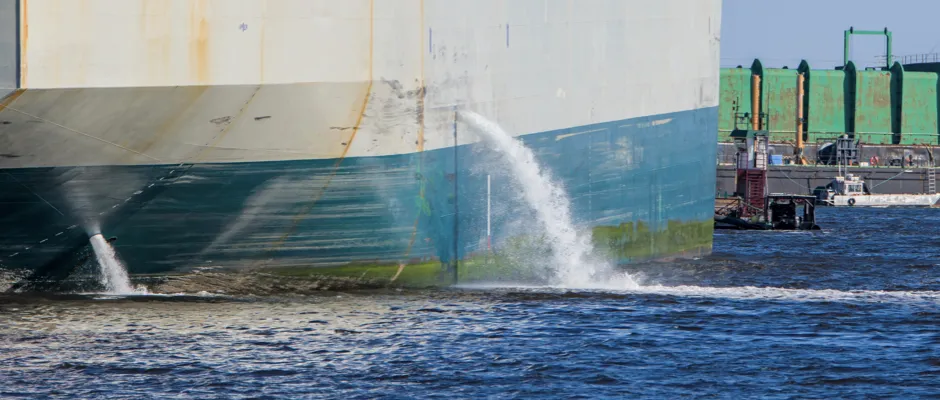Alternative Techniques for Ballast Water Treatment
Ships use ballast water to maintain stability during their voyages. However, this water can contain harmful organisms and pathogens that are not native to the areas where it is discharged. When ballast water is released into a new environment, these organisms can establish themselves as invasive species. This leads to the disruption of local ecosystems, threatens biodiversity, and can cause significant economic damage to fisheries, aquaculture, and other maritime activities.
To minimize these risks and comply with regulations such as the Ballast Water Management Convention (BWMC) of the International Maritime Organization (IMO) and the requirements of the United States Coast Guard (USCG), the implementation of effective ballast water treatment systems (BWTS) is crucial for shipowners and operators.
In addition to widely used techniques like electrolysis (EC) and UV radiation – which are often combined with filtration to remove large particles and organisms from ballast water – there are various other effective solutions available. Each method has unique advantages and disadvantages depending on factors such as the type of ship, water quality, and applicable regulations. This article discusses the main alternative methods for ballast water treatment, their benefits, drawbacks, and suitable applications.
Filtration and Sedimentation
Filtration and sedimentation are mechanical methods that remove larger particles and organisms from ballast water. Filtration systems use fine-mesh filters to intercept particles, while sedimentation systems utilize gravity or centrifugal forces to separate particles. The main advantage of these techniques is that they do not use chemicals, making them environmentally friendly. A drawback is that they are less effective against microscopic organisms such as bacteria and viruses. These methods are often used as pre-treatment steps in combination with other techniques and are suitable for ships operating in waters with high sediment content.
Advanced Oxidation Processes (AOP)
Advanced oxidation processes (AOP) combine oxidizing agents such as UV light, ozone, and hydrogen peroxide to produce highly reactive hydroxyl radicals. These radicals effectively break down organic substances and microorganisms. The primary advantage of AOPs is their high efficiency against a wide range of contaminants, including resistant organisms. A disadvantage is that these systems are complex and expensive in both installation and maintenance. AOPs are particularly suitable for cruise ships and passenger vessels where high water quality is essential.
Electrochemical Treatment
Electrochemical treatment uses advanced electrode systems to inactivate microorganisms without adding additional chemicals. By passing an electric current through the water, reactive species such as free radicals and ozone are generated, which destroy harmful organisms. The benefit of this method is that no chemical storage is required onboard, reducing safety risks. A drawback is the high energy consumption and initial investment costs for the equipment. Electrochemical treatment is suitable for modern ships with sufficient power supply, such as offshore installations and advanced cargo vessels.
Deoxygenation
Deoxygenation removes oxygen from ballast water by injecting inert gas, such as nitrogen, into the ballast tanks. This process suffocates aerobic organisms that depend on oxygen to survive. The main advantage of this technique is that it does not require chemicals or UV light, making it environmentally friendly. However, a disadvantage is that the process is time-consuming and requires airtight tanks, making it less suitable for ships with short voyages. This method is primarily suitable for larger ships such as oil tankers that travel long distances.
Heat Treatment
Heat treatment utilizes excess heat from the ship’s engine to heat the ballast water to a temperature that kills microorganisms. This process is highly efficient because it utilizes existing heat sources, eliminating the need for additional chemicals. A drawback is that prolonged exposure to heat can cause corrosion in the tanks. Additionally, the method is relatively slow, making it less suitable for ships that require rapid ballast water treatment. This technique is especially popular among large cargo ships and LNG tankers.
Ultrasonic Cavitation
Ultrasonic cavitation uses high-frequency sound waves that create pressure differentials in the water, destroying the cell structures of microorganisms. This technique is particularly effective against smaller organisms and operates without chemicals, making it an environmentally friendly choice. The system is often combined with filtration to enhance efficiency. Despite the higher costs of the equipment and the regular maintenance required, ultrasonic cavitation is a good choice for ships operating in coastal waters with variable water quality, such as ferries and offshore supply vessels.
Magnetic Field Treatment
Magnetic field treatment uses strong magnetic fields to alter the properties of the water, causing microorganisms to aggregate and become easier to remove. This system is effective for removing larger organisms and does not require chemicals, making it an environmentally friendly option. However, a disadvantage is that the installation is expensive and the system is less suitable for removing microscopic organisms. This method is often applied to large industrial ships and cargo vessels in waters with high organic content.
Pasteurization
Pasteurization uses excess heat from the ship’s engine to heat the ballast water and kill harmful organisms. This chemical-free method is highly energy-efficient because it optimally utilizes residual heat. The main limitation, however, is that a constant heat source is required, which can complicate integration on some ships. Pasteurization is especially suitable for tankers and large cargo ships with long voyages.
Chemical Injection
Chemical injection involves injecting pre-produced biocides, such as chlorine, directly into the ballast water. This method does not require electrical power as in electrolysis, but it does require the storage and management of chemicals onboard. This often leads to higher operational costs and strict safety measures. Chemical injection is particularly useful for ships operating in diverse waters, as it is effective in waters with varying salinity levels.
Ozone Treatment
Ozone treatment uses ozone, a strong oxidant generated from ambient air, which is injected into the ballast water. This process oxidizes and destroys microorganisms, but the system poses risks such as the potential for corrosion of ballast tanks. Additionally, a complex ozone management system is required to ensure safety. Ozone treatment is especially suitable for ships with large ballast water flows operating in waters with high organic content, such as industrial vessels and bulk carriers.
Recent Developments and Innovations
In recent years, there have been significant innovations in ballast water treatment. There is a growing trend toward the development of hybrid systems that combine multiple technologies, such as filtration with UV radiation or electrochemical processes, to more effectively eliminate a broader range of microorganisms. Additionally, modern systems increasingly incorporate advanced sensor technologies and automation for real-time monitoring and optimization of the treatment process. These systems are not only more efficient but also more energy-efficient and environmentally friendly, contributing to lower operational costs and a reduced ecological footprint.
Considerations When Choosing a System
Like conventional techniques such as electrolysis (EC) and UV radiation, various factors play a crucial role in selecting an alternative ballast water treatment system (BWTS). Important considerations include the type of ship, ballast water flow, and water quality. Ships with long voyages and large ballast volumes often benefit from systems such as heat treatment, pasteurization, or advanced oxidation processes, as these techniques make optimal use of the available onboard resources. For smaller ships with shorter routes, ultrasonic cavitation and magnetic field treatment are generally better choices due to their rapid operation and lower energy consumption.
It is essential that the chosen system complies with both environmental requirements and the operational needs of the ship. This must be done in accordance with international and national regulations, such as the Ballast Water Convention of the International Maritime Organization (IMO) and the requirements of the United States Coast Guard (USCG). Moreover, it is advisable to consider combinations of different techniques to ensure optimal efficiency and regulatory compliance.



